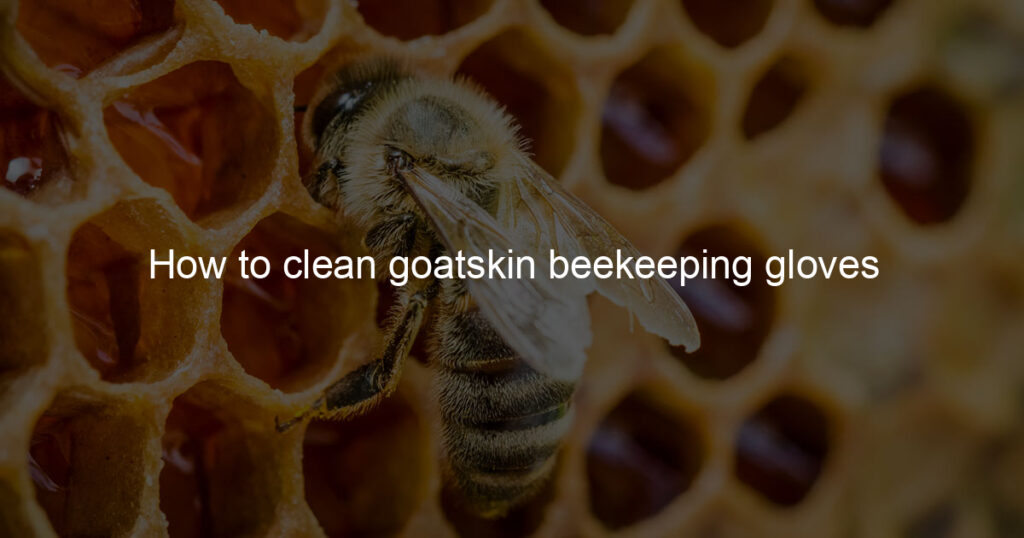Beekeeping is one of the most important agricultural practices out there, so having the right equipment to keep you and your hives safe while performing tasks such as hive maintenance or inspections is a must.
Without proper protection, bee stings can seriously injure or even harm those working with them. That’s why getting the ideal gloves for beekeeping is crucial to maintaining safety in this delicate industry. And when it comes to quality protective gear specifically designed for handling bees, nothing beats goatskin gloves! Not only are they light and durable enough to protect your hands from stings but also breathable enough that you won’t overheat on summer days either. Read on as we discuss how best to clean these amazing protective gloves so that you can stand up against hundreds of buzzing bees without worry!
How do you wash beekeeper gloves?
Beekeeper gloves can last a long time with proper care, and an important part of that is washing them after each use. To wash them effectively without ruining the material, it’s best to turn the inside out and submerge them in warm water with a mild detergent carefully.
Then, rinse the gloves thoroughly and air dry. Once dry, you can either apply leather conditioner or rub vegetable oil inside and outside for a protective layer to safeguard them from future wear and tear. Doing this regularly can keep your beekeeping gloves clean and safe for many bee-filled days!
Can goatskin gloves get wet?
One of the most important considerations when it comes to selecting a pair of gloves is whether or not they can stand up to the elements. Those who are looking for gloves that will keep their hands dry in wet weather may be wondering if goatskin gloves can get wet.
The answer is yes; goatskin, like many other natural materials, is naturally water-resistant and so will remain substantially dry even when immersed in water. Therefore, if you’re looking for a pair of gloves that won’t suffer from constant submersion in water, goatskin is an excellent choice.
Furthermore, its natural flexibility makes it a great option for those who need dexterity while warding off moisture!
How do you remove propolis from bee gloves?
Beekeeping gloves are an essential tool for anyone starting with beekeeping and can make the process easier if they’re properly maintained. Propolis is a sticky adhesive that bees use to build their hives, and can easily get stuck to your gloves while handling the hives. Fortunately, it’s not too hard to remove propolis from your gloves; three simple steps can do the trick.
First, shake out as much propolis residue as you can from your gloves. Next, spray the affected area generously with either liquid soap or rubbing alcohol. Finally, rinse the area with water and pat dry with a soft towel afterward—voila! Your gloves will be just brand new and ready for more beekeeping activities.
Can you wash bee suit gloves?
Beekeepers rely on their bee suit gloves for protection when handling bees. These specialized gloves are made from a combination of materials that can provide an extra layer of defense to the wrists, hands, and arms against stings. But, to continue to be effective, these gloves must be cared for correctly.
Fortunately, washing bee suit gloves regularly is possible with a little bit of effort and knowledge. To clean your gloves and extend their lifespan, simply use warm water and mild soap or detergent then air dry after washing. It’s important to keep a regular maintenance cycle to make sure these special gloves last as long as possible.
How often should you wash your bee suit?
Bees play an important role in the environment and they need to be respected. Wearing a bee suit when tending to them is essential to staying safe and protecting yourself, but it’s also critical that you keep your suit clean.
To ensure you maintain its integrity, make sure to wash your bee suit after every use, especially if it seemed like there was heightened activity among the bees or if it got damp from sweat or moisture.
Washing your bee suit decreases the likelihood of residue on the material which could attract additional bees or swarms. Though washing your bee suit can take some extra time, it’s worth the effort to ensure safety for both you and the bees!
Winding Down: How to clean goatskin beekeeping gloves?
Cleaning goatskin beekeeping gloves may not be the most glamorous of tasks however, it is an important part of being a successful beekeeper. After all, if you don’t take the time to keep your gear clean, you’ll have a difficult time getting any of your apiculture work done.
Thankfully, with the right approach and materials, cleaning and caring for goatskin gloves can be fairly straightforward. In some cases, you won’t even need to use harsh chemicals or serious elbow grease!
All that’s left to do is make sure you routinely inspect and maintain your gear so that when it’s time to clean up again, you won’t find yourself caught short. Take your time and assure yourself that nothing gets overlooked; after all, your bees depend on you!








